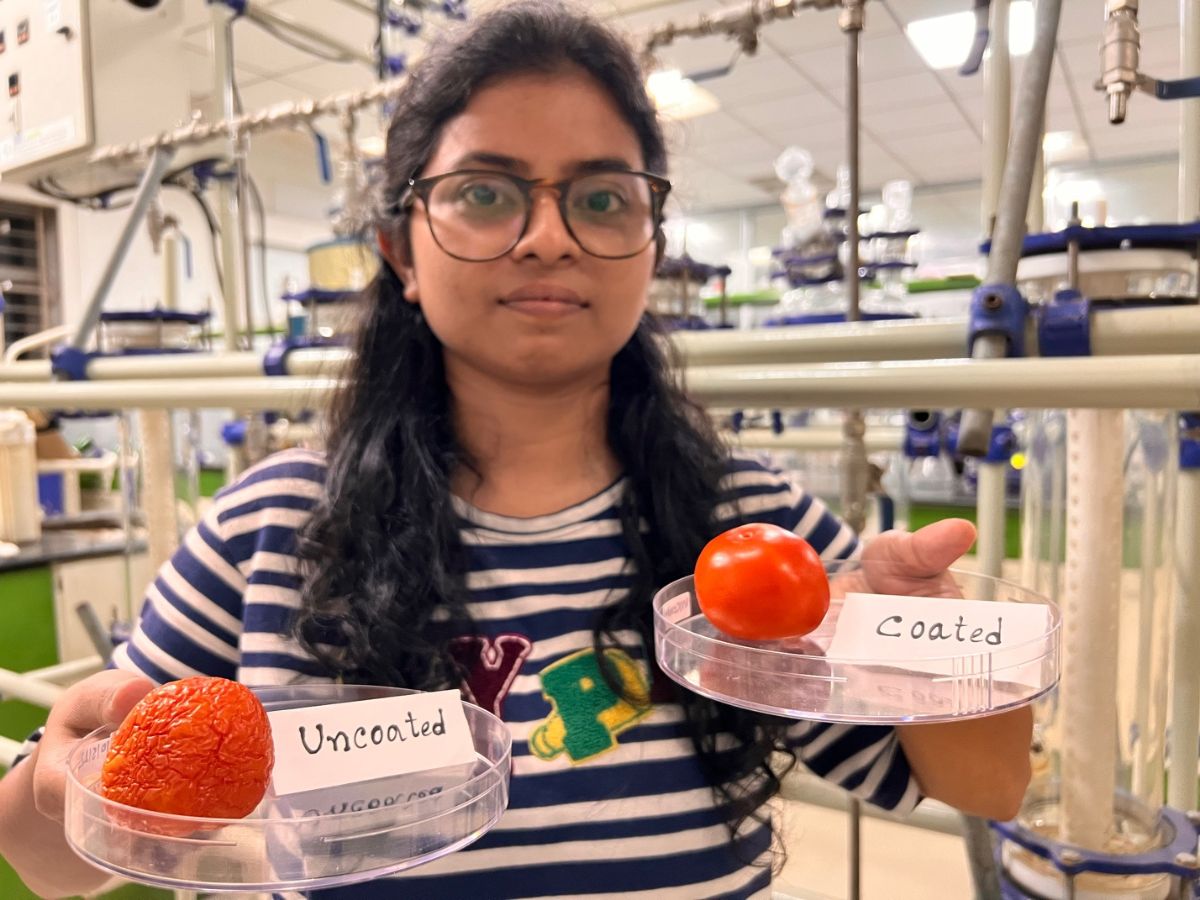IIT Guwahati Researchers Develop Edible Coating To Extend Shelf Life Of Fruits And Vegetables
The study found that the fruits and vegetables remain fresh for nearly two months after the edible coatings are applied. These edible coatings will ensure that food remains safe for longer durations.

Researchers at the Indian Institute of Technology Guwahati have developed biodegradable, edible coatings that extend the shelf life of fruits and vegetables, and keep harvest safe from sprouting and rotting. These edible coatings will ensure that food produce remains safe for longer durations, and that India's United Nations Sustainable Development Goal (SDG) targets on reducing food losses in production and supply chains.
The researchers tested the edible coating material on fruits and vegetables such as potatoes, green chillies, tomatoes, strawberries, Khasi Mandarin, apples, kiwi, and pineapples. The study found that the fruits and vegetables remain fresh for nearly two months after the edible coatings are applied.
The SDG target 12.3 is aimed at reducing food losses along the production and supply chains, including post-harvest losses. The edible coating developed by the researchers could help India meet this target.
The results of the research have been published in the journals Royal Society of Chemistry Advances and American Chemical Society's (ACS's) Food Science and Technology.
How Is The Edible Coating Made?
The researchers formulated the edible coating material using a de-oiled crude green algal ethanolic extract (CAEE) and chitosan, according to the study published in ACS. Chitosan is a polysaccharide produced by treating chitin with an alkaline substance such as sodium hydroxide.
The researchers applied the edible coating material on red tomatoes, with an aim to minimise post-harvest losses and prolong the shelf life with improved quality attributes. The team subjected the waste biomass of the marine microalgae Dunaliella tertiolecta to ultrasound-assisted solid-liquid extraction, in order to obtain an antioxidant-rich extract. The organism is known for its antioxidant properties and has various bioactive compounds such as carotenoids, proteins, and polysaccharides.
The organism is used as a source of algal oil, as it is rich in Omega-3 fatty acids. The team extracted the oil, and used the residue to develop the edible film.
Then, the researchers developed the coating material by mixing aqueous chitosan in mild acetic acid medium with the algal extract. They prepared mixtures at varying concentrations.
Chitosan, a carbohydrate, has antimicrobial and antifungal properties. Millipore water, which is deionised water, was used as a control coating material.
Storage Conditions For The Food Item
The team stored the coated and control tomatoes for 30 days under ambient conditions (27 to 30 degrees Celsius, and 60 to 70 per cent relative humidity).
What Exceptional Properties Do Tomatoes Coated With The Edible Material Exhibit?
The study found that the tomatoes coated with the edible coating formulation had a longer shelf life than the control tomatoes. Also, the tomatoes coated with the edible coating formulation exhibited improved physicochemical properties such as antioxidant activity, and larger amounts of lycopene and ascorbic acid contents. These tomatoes had increased firmness because the coatings restricted faster respiration and decreased ripening rates during ambient storage.

The Algal Extract And Chitosan Polymer Have Antioxidant And Antimicrobial Properties
The study authors concluded that the edible coating enhanced the shelf life of tomatoes by around one month while storing under ambient conditions. Since the algal extract consists of various bioactive components, including beta-carotene, it confers antioxidant and antimicrobial properties to the coated tomato. Thus, the tomatoes are protected from oxidation and microbial decay during storage.
The chitosan biopolymer also has inherent antioxidant and antimicrobial properties. As a result, the physicochemical and biochemical properties of the coated tomatoes are retained and improved.
How Did The Edible Coating Enhance The Properties Of Green Chillies?
In the study published in the Royal Society of Chemistry Advances, the researchers coated green chillies with the edible coating formulation. The addition of the algal extract to the chitosan matrix reduced water vapour permeability, improved the crystallinity of the food, and increased its tensile strength. The coating material exhibited antimicrobial activities against common food pathogens.
How Was The Coating Applied On Green Chillies?
The researchers applied the coating solution on green chillies using a dipping method and stored them at ambient temperatures for 10 days. They observed that the shelf life of chillies was extended without altering the quality, as compared to the uncoated green chillies.
The researchers also developed multiple customised edible coating formulations to enhance the shelf life of the food produce based on the requirements.
Are The Edible Coatings Toxic?
In order to test the biosafety of the coatings, the researchers treated the formulation with BHK-21 cells, which are cells derived from the kidneys of baby hamsters and used for studying the toxicity effects of various materials. The team found that the coating materials were non-toxic, and could be safely used as primary as well as secondary edible food packaging materials.
The Edible Coatings Could Also Be Used As Storage Pouches
The coatings were tested on a range of fruits and vegetables, and can be directly coated on the food item, or made into a storage pouch. Since the coating can be applied through a simple dipping method, there are no significant additional costs after post-harvest processing.
Up To 15.9% Fruits And Vegetables Go Waste Post-Harvest
In a statement released by IIT Guwahati, Professor Vimal Katiyar, who co-authored both papers, said that between 4.6 and 15.9 per cent of fruits and vegetables go waste post-harvest, partly due to poor storage conditions. He explained that post-harvest loss in certain produce items like potato, onion, and tomato could be as high as 19 per cent.
How Are The Newly Developed Coatings Unique?
Professor Katiyar said that the newly developed coatings can be mass-produced and are unique, very stable to light, heat, and temperature up to 40 degrees Celsius, edible, can be safely eaten as part of the product formulation, and do not add unfavourable properties to it. The edible materials retain the texture, colour, appearance, flavour, and nutritional value and microbial safety of the fruit or vegetable that has been coated. This increases the shelf life of the fruit or vegetable by several weeks or months.
How Will The Edible Coatings Be Beneficial To Society?
In the study published in Royal Society of Chemistry Advances, the authors concluded that the algal extract was rich in antioxidants and various bioactive compounds, especially carotenoids, proteins, and polysaccharides. The edible films displayed a superior antioxidant activity, water vapour barrier property, thermal stability, and mechanical strength.
The developed edible active film also exhibited an excellent property of blocking ultraviolet and visible light. Also, the coating material was found to be biocompatible and non-toxic. The researchers also made edible pouches as secondary packaging material to ensure the chillies were preserved for a longer period.
Therefore, the edible coating developed by the IIT Guwahati researchers could be a promising solution for extending the shelf life and preventing post-harvest losses of fresh produce. Agronomists could use this simple technology to keep fruits fresh for longer durations after harvesting.
Related Video
Southern Rising Summit 2024: How Important is Self-Awareness? Insights from Anu Aacharya | ABP LIVE






































